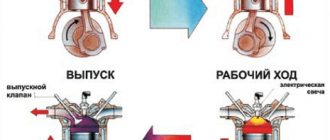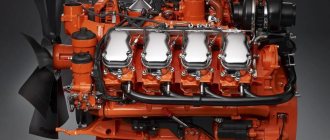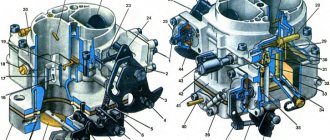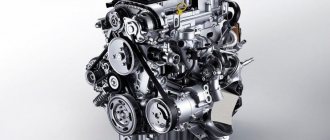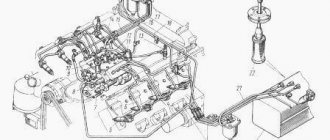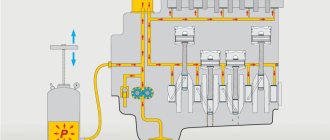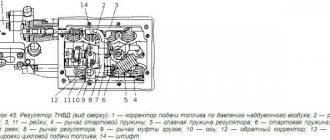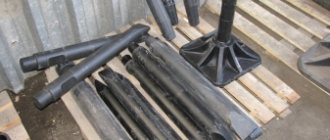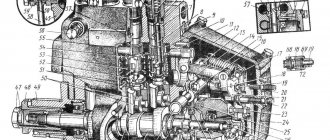The carburetor is the energy responsible for feeding the cylinders with the fuel-air mixture. It is located at the intake manifold, and its main source is the supply of the fuel-air mixture to the engine cylinders. The air filter is located directly above the carburetor, which is responsible for cleaning the air, which then enters the car's cylinders.
prokarbyrator.ru
The carburetor works completely differently than current injectors in engines. Fuel is delivered to them through the throat. Fuel injection into the intake system due to the operation of air intakes that open for a few milliseconds.
A carburetor engine refers to an internal combustion system. How does a carburetor engine work? In such a system, air is mixed with gasoline, the mixture burns, and it is possible to regulate its flow. On practice. Cars with carburetors are going out of fashion; they are being replaced by injection engines.
Carburetors are virtually no longer used in the automotive industry due to environmental restrictions (clean exhaust gas), and such solutions are still common in motorcycles. The idea of the carburetor fuel supply system is that the required amount of fuel to create a fuel-air mixture is not injected through the nozzle (as in the case of a fuel injection system), but is sucked from the nozzle located centrally in the neck of the carburetor by the air flowing through it at high speed.
In the injection system, a computer, analyzing signals coming from various sensors (lambda probe, flow meter), selects the optimal dose of fuel, which will then be used to create a fuel-air mixture. In the carburetor supply system, the amount of fuel sucked in is determined only by the air pulse in the throat and static controls (gearboxes, injectors, emulsion tubes - changing their settings requires disassembling the carburetor and manually adjusting them).
The carburetor is a system that consists of:
- Float.
- Float chambers.
- Jet.
- Sprayer.
- Diffuser.
- Throttle valve.
The carburetor, according to the website prokarbyrator.ru, is installed on the intake manifold and is responsible for supplying gasoline to the engine after mixing it with air. There is also an air source directly above it.
Fuel is supplied (aspirated) to the carburetor by negative pressure at the throat, while injection forces fuel into the intake manifold, which opens for a few milliseconds.
The carburetor can be divided into a float chamber and a throat with a passage. The float chamber and the name of the same name from the float, which floats on the fuel accumulated in it. A needle valve is installed on the float lever, which blocks the flow of gasoline from the fuel tank and prevents spontaneous flow of fuel from the nozzle into the neck. The upper end of the local injectors is located in the neck above the maximum fuel level in the float chamber. Gasoline simply needs to be sucked out of the nozzle to apply a vacuum at the narrowest point.
Therefore, when the accelerator pedal is pressed, the throttle valve opens, the engine sucks in more air and more fuel is sucked from the injector. It is in the throat that the sucked dose of gasoline mixes with air and moves into the intake manifold, and then into the cylinder that is currently being sucked.
A carburetor is more than just the neck, throttle valve and float chamber.
Carburetors have many components that ensure the engine is properly powered. It turns out that using a vacuum to suck fuel into the engine cannot guarantee the optimal mixture composition in all engine operating modes (cold engine start, idling, dynamic acceleration, engine braking). Therefore, carburetors are equipped with booster devices, and some of them have more passages.
There is a choke in each throat (passage). However, each of these dampers can open to a different extent. For example, with a two-barrel carburetor, if the accelerator pedal is depressed halfway, the first throttle will be half open and the second throttle will be closed. However, when pressing the gas harder, the first throttle will open to 100% and the associated mechanism will open the second throttle to the appropriate range. Some designs, such as older sports cars, had carburetors in which each passage fed one cylinder.
Combustible mixture and its types.
The flammable mixture is a mixture of gasoline vapor and air. Entering the engine cylinders, the combustible mixture is mixed with residual exhaust gases and forms a working mixture.
In engines, combustion of the working mixture occurs in thousandths of a second (0.002 - 0.003 s). Such rapid combustion is possible provided that the fuel is in a vapor state in the form of tiny particles and there is a sufficient amount of air for combustion. Depending on the mass ratio of gasoline and air, the following types of combustible mixtures are distinguished: normal, enriched, rich, lean, lean.
Normal
called a mixture in which 1 kg of gasoline contains 15 kg of air (12 m3). With this mixture, the engine operates steadily and has average power and efficiency indicators.
Enriched
the mixture contains 13 - 15 kg of air per 1 kg of gasoline, the combustion rate of such a mixture increases, the engine develops more power, but at the same time fuel consumption increases.
Rich
the mixture contains less than 13 kg of air per 1 kg of gasoline, it burns slowly, engine power decreases, and large excess fuel consumption occurs.
Lean
the mixture (1: 15 - 16.5) ensures complete combustion of the fuel, engine power is slightly reduced, but the greatest fuel savings are achieved.
Poor
the mixture contains more than 17 parts air to one part gasoline. It burns very slowly, the engine overheats, fuel consumption increases, and power drops significantly.
The process of preparing a combustible mixture is called carburetion, and the device that prepares the mixture is called a carburetor.
. https://aboutavtobus.ru/ustrojstvo-i-rabota-karbyuratora.html
The operation of the simplest carburetor is based on the principle of spraying.
The simplest carburetor consists of floats and mixing chambers. The float chamber contains a brass float, hinged on an axis, and a needle valve. The mixing chamber contains a diffuser, a nozzle with a spray and a throttle valve. The jet represents the flow rate of the fuel.
When the engine is running, when the piston moves down and the intake valve is open, a vacuum is created in the cylinder, intake pipe and mixing chamber of the carburetor, under the influence of which fuel flows out of the nozzle at a speed of 2 to 6 m/s. At the same time, an air flow passes through the mixing chamber, the speed of which in the narrowed part of the diffuser reaches 50-150 m/s.
Due to the high speed of air from its impacts, fuel droplets are gradually crushed, turned into vapor and, mixing with air, form a combustible mixture. As fuel is consumed, the float lowers, the needle valve opens the hole and fuel begins to fill the float chamber again. In this way, a constant fuel level will be maintained in the float measure and in the nozzle, in which it should be 1-1.5 mm below the upper edge of the nozzle when the engine is not running.
The simplest carburetor does not provide the required change in the composition of the combustible mixture when moving from one engine operating mode to another. So, when moving from low to medium loads, instead of leaning, it enriches the mixture. In addition, it does not have devices with which you can enrich the mixture when starting a cold engine, under heavy loads, during acceleration of the car, and it also does not ensure stable engine operation at low crankshaft speeds. Therefore, more complex carburetors are installed on engines, ensuring the preparation of a mixture of the desired composition in all modes. This is achieved by the presence of the necessary devices and systems in the carburetor: the main metering system, the starting system, the idle system, the economizer and the accelerator pump.
The main metering system consists of a fuel jet with a sprayer and an air jet.
When a carburetor engine operates during the intake stroke, a vacuum is created in the mixing chamber above the nozzle. Under the influence of decomposition, which increases as the throttle opening increases, fuel flows through the nozzle into the atomizer and into the mixing chamber. As the vacuum in the diffuser increases, air enters the atomizer through the air nozzle. The greater the vacuum, the more air is added. Thus, the air jet slows down the flow of fuel from the main jet under the influence of increasing vacuum and thereby ensures that an economical mixture of a constant lean composition is obtained, regardless of the increase in vacuum in the diffuser with increasing opening of the throttle valves. When working simultaneously with other systems, the main dosing system prepares enriched and rich mixtures.
The idle system ensures the preparation of a rich mixture when the engine is running warm and at low crankshaft speed. In this mode, the cylinders are poorly cleaned of residual gases, which prevent the spread of flame in the cylinder. And although the effective power at idle is zero, the mixture is enriched to speed up combustion and ensure smooth engine operation. When the engine is running at low crankshaft speed, the carburetor air damper is open and the throttle valve is closed, the vacuum in the diffuser is insignificant and the main metering system does not work. A vacuum is created below the throttle valve, and fuel flows through the main metering system jet to the idle fuel jet. After passing through this jet, it mixes with the air entering through the first air jet and forms an emulsion (a foamy mixture of fuel with air bubbles). The resulting emulsion enters the emulsion channel, then exits through the lower spray hole into the throttle space. When the throttle valve is opened to a small angle, the emulsion will also flow through the upper sawing hole. The presence of two outlets in the idle system ensures a smooth transition from idle to medium and heavy loads.
The mechanically driven economizer consists of a jet and a well in which the needle clan is placed. The economizer is driven from the throttle valve using a lever and a rod with a bar and a rod. As the throttle valve opens, the drive lever turns and moves the rod, which lowers the rod 3 with the needle down through the bar. When the throttle valve is opened by more than 85%, the rod opens the valve and additional fuel begins to flow from the well through the nozzle into the atomizer, i.e., additional fuel passing through the open economizer valve is added to the fuel entering through the nozzle.
The amount of fuel entering the mixing chamber is limited by the economizer jet, the throughput of which is designed to prepare a rich mixture to obtain maximum power.
The accelerator pump serves to temporarily enrich the combustible mixture when the throttle valve is opened sharply, which improves the vehicle's throttle response (accelerates acceleration). An accelerator pump is often combined with an economizer. When the throttle valve is opened sharply, under the action of the lever, rod and drive bar, the piston in the well quickly moves down. Due to the resulting fuel pressure, the check valve closes, the discharge valve opens, and a portion of fuel is injected through the atomizer into the mixing chamber, enriching the combustible mixture.
The starting system serves to enrich the combustible mixture when starting and warming up a cold engine. When starting a cold engine, insufficient evaporation of fuel occurs, and gasoline in a droplet state does not participate in combustion. Therefore, during the period of starting and warming up the engine, it is necessary to provide a rich combustible mixture, which is achieved by closing the carburetor air damper by pulling the button on the instrument panel. In this case, a significant increase in vacuum in the mixing chamber causes increased fuel flow from the main metering system and the idle system. To prevent over-enrichment of the combustible mixture, an automatic valve with a spring is installed on the air damper, which, when the air damper is closed, under the influence of vacuum in the mixing chamber, opens and allows a certain amount of air to pass through.
Carburetor control
As a rule, the actions of the carburetor are controlled by the driver of the car. Some models of carburetors used auxiliary systems that slightly automated carburetor control.
In order to control the throttle valve, the gas pedal is most often used, which determines its mobility with the assistance of a rod system or cable drive. Traction is usually better, but the drive mechanism is much more complex and hinders the mechanism’s ability to arrange the engine compartment area. Rod drive was popular until 1970, then metal cables began to be used more often.
On older cars, a dual carburetor throttle valve drive system was often assumed: manually using a lever or from the foot using a pedal. If you press on the pedal, the lever does not move, but if you move the lever, the pedal goes down.
Subsequent opening of the throttle can be done using the pedal. When the pedal is lowered, the throttle remains in the same position in which it was fixed when controlled by hand. For example, on the Volga GAZ-21, a lever was placed on the instrument panel to control the hand; by moving it, you can achieve constant operation of a cold engine without the action of the air damper, or use “constant gas”. On trucks, "constant throttle" was used to make reversing easier.
The air damper can be equipped with a mechanical or automatic drive. If the drive is mechanical, then the driver closes it using a lever. The automatic drive is very popular in other countries, but in Russia it has not “taken root” due to its unreliability and short service life.
Carburetor engine design
The power system is used to store, supply, supply and purify fuel, purify air, prepare a combustible mixture of the required composition and remove combustion products to the outside.
The power supply system of a carburetor engine includes: fuel tank, fuel lines, fuel filters, fuel pump, air filter, carburetor and intake manifold. The power system also includes the engine exhaust pipe and muffler.
The supply of fuel for engine operation is stored in the fuel tank, from which fuel is supplied to the carburetor by the fuel pump through the fuel lines. The sediment filter cleans the fuel from mechanical impurities and separates any water that accidentally gets into it. The air filter removes dust from the atmospheric air entering the carburetor. The carburetor prepares the combustible mixture, which enters the cylinders through the intake manifold. The exhaust pipe removes exhaust gases from the cylinders. The muffler reduces the temperature of the exhaust gases and reduces noise when escaping into the atmosphere.
Pros of the injector
It’s worth saying right away that engines with injectors have much more power than carburetor engines. And, in terms of power, an injection-type engine can exceed its carburetor counterpart by 10%. Many factors influence the power of an injection engine, first of all: fuel injection (this method is radically different from the carburetor method), the shape of the intake manifold, and the set ignition angle. In an injection engine, fuel consumption is much more economical than that of its “colleague”. This is achieved thanks to the control of the accuracy of the fuel mixture supply by the electronic system. Because of this, partial combustion of fuel does not occur in the system. Undoubtedly, the most important reason for the massive transition to injectors was the high environmental friendliness of such engines, which is very important at the present time. As already mentioned, significantly less emissions of harmful substances occur in an injection engine. If the engine starts in winter, that is, in the cold season, it is not at all necessary to warm it up. In addition, injection engines are particularly reliable, and breakdowns are very rare. And it is also worth noting that fuel-injected cars do not have a distributor coil, but as a rule, it breaks down very often.
Cons of the injector
In addition to the advantages, the disadvantages of the injector should also be noted, although they are not so significant. No matter how reliable the injector is, like any other device it can break. And, if a breakdown has occurred, then it is impossible to do without special electronic diagnostics, that is, it is not possible to determine the breakdown “by eye”. And you won’t be able to carry out repairs yourself without the necessary skills. And the price of repairing injectors in auto repair shops is quite high; replacing an injector with a new one is also not a cheap pleasure. As a result, repair and maintenance of the injector is a very expensive undertaking. Also, the injection engine reacts very painfully to the quality of the fuel. Low-quality gasoline with a suspicious composition can lead to extremely unpleasant consequences for the injector, including its complete failure. And in this case, it is necessary to clean the injector; the cost of this procedure is quite high. It is also worth noting an important disadvantage that the injector can lead to overheating of the engine if the injection system is installed instead of the carburetor. This is directly related to the fact that fuel burns in a larger volume in the injector than in the carburetor, and this, in turn, leads to an increase in temperature in the engine cylinders.
Characteristics
Engine performance is determined by its power, effective pressure, torque, speed and rotational speed of the crankshaft and fuel consumption.
The power of a carburetor engine, as well as its torque, is dependent on the crankshaft rotation speed and pressure height.
The speed characteristic of a carburetor engine is set by the highest power that can actually be obtained from pressure at different crankshaft speeds.
At low crankshaft speeds, the pressure in the cylinders is low and the engine power, accordingly, is also low. As the crankshaft rotates faster, the pressure rises as the combustible mixture burns faster.
Fuel consumption increases at a low crankshaft speed, since the combustion process is slower, heat transfer is greater, and as the speed increases, mechanical and thermal costs increase.
The speed characteristics of a diesel engine are determined by a fixed rack of the fuel pump, which provides high fuel supply at a specific speed mode and smoke-free operation.
When the car engine is running, the number of crankshaft rotations changes. If fuel consumption increases for no reason, this is due to a deterioration in the engine's operating process.
